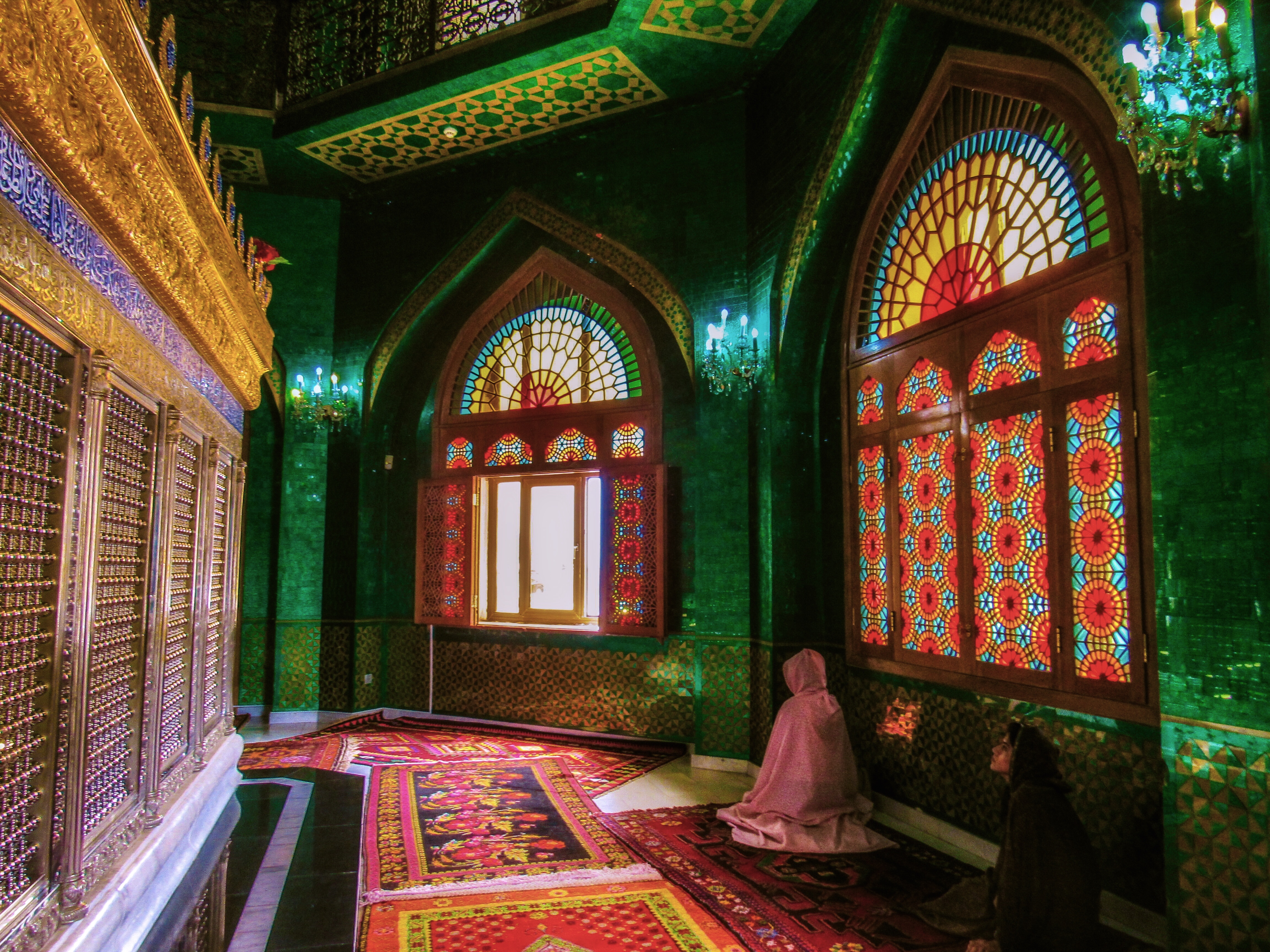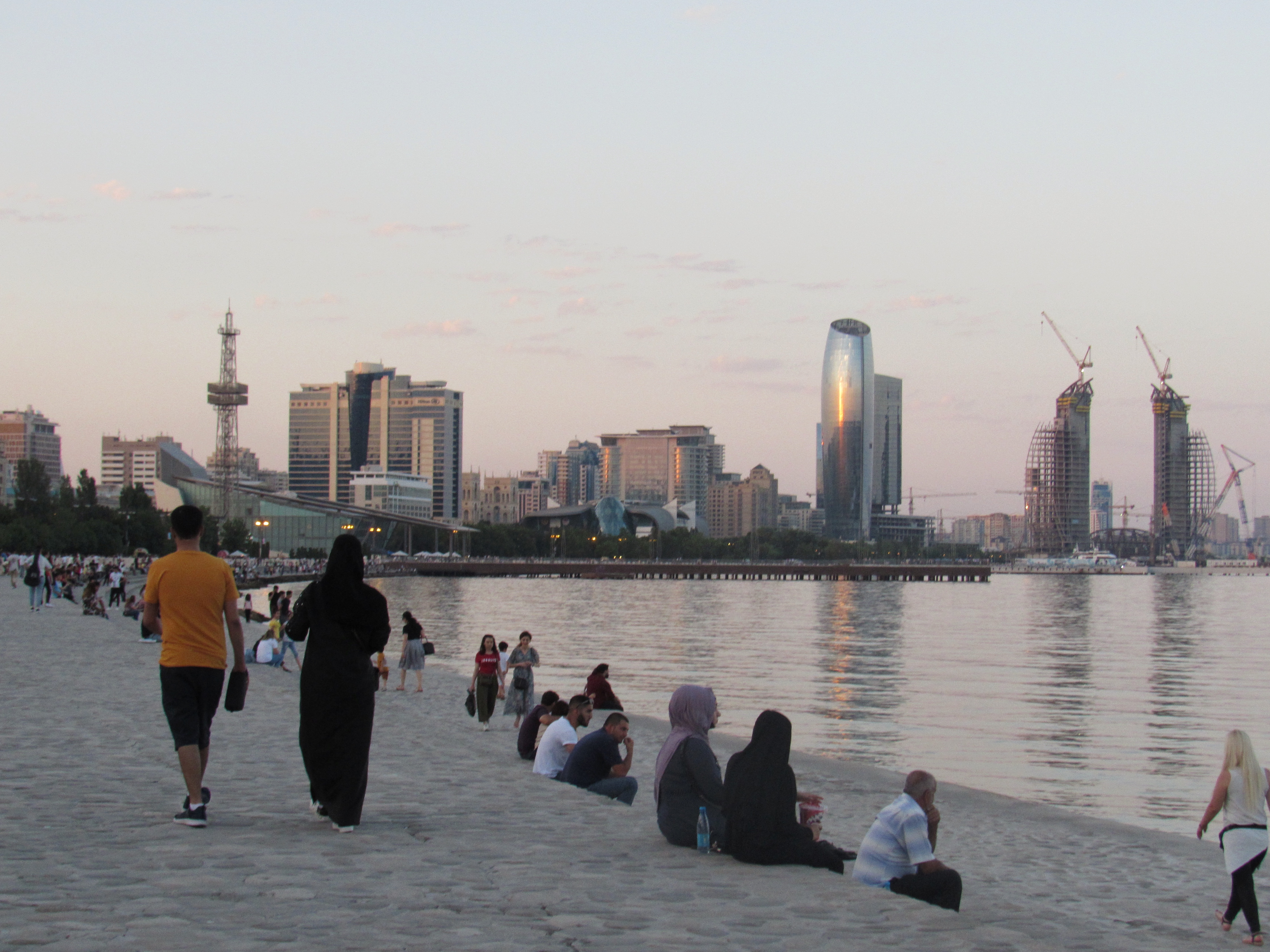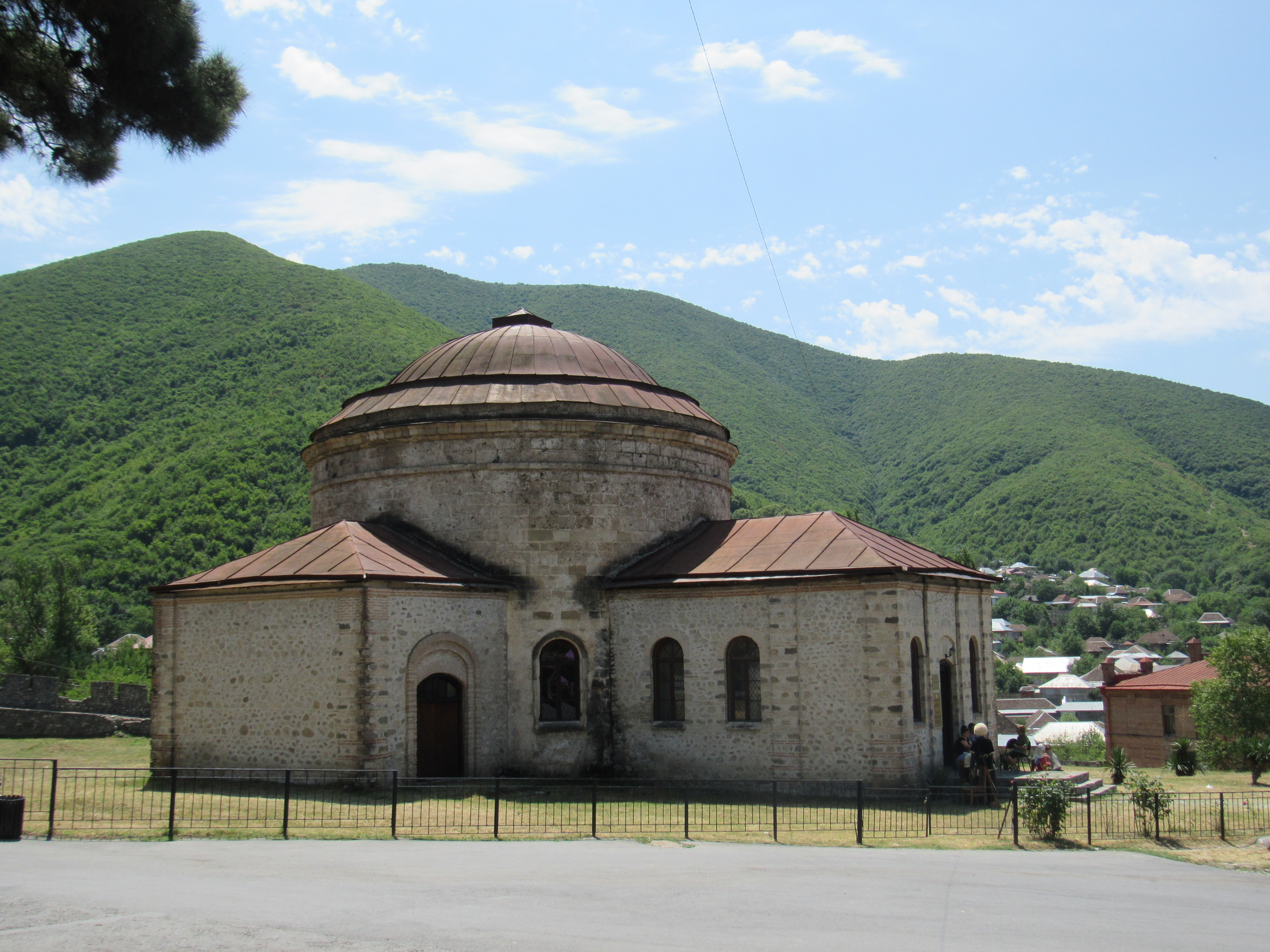We were rudely awoken from our cabin on the Caspian Sea ferry and unceremoniously dumped in Azerbaijan at 4am. I was still asleep on arrival and would have really liked to just curl up in a corner somewhere and wait for morning. We weren’t prepared at all, with no Azeri currency or SIM cards, and there was nothing at the port except a guy stamping passports and a huge gang of friendly dogs. When our ferry companions, the three students from Kazakhstan, suggested we walk to the highway and hitch-hike the 70km to Baku, it seemed like a good idea. They insisted on carrying our packs, bless them. There are advantages to being ‘older’ travellers. We walked, in the dark, for what seemed like miles and miles until we reached the highway. JH and I got bundled into the first car that stopped and we were on our way. The driver chatted away to us all the way but we had no idea what he was saying or even what language he was speaking. The only word we could find in common was ‘coffee’, so when we got to Baku he drove all over the city until he found an open coffee shop. We were so very grateful.
The Caucasian countries – Azerbaijan, Georgia, Armenia and some ‘disputed territories’ – inhabit an area of the world I picture as a kind of ‘Middle Earth’. Lying between Asia and Europe, they’re neither one or the other but have a foot in each. It’s a rather precarious position sandwiched between Russia to the north and Turkey and Iran to the south. Over the last few thousand years they’ve been repeatedly fought over and occupied by each of them.
Azerbaijan is an unusual and fascinating country. It also has a very cool name that’s fun to say. It’s so rich in oil and natural gas that it’s literally oozing up out of the ground. This sometimes causes spontaneous fires that can burn indefinitely, like the very strange continuously ‘burning mountain’ of Yanar Dag.

The people here were traditionally fire-worshippers, for obvious reasons. It’s thought that the Ateshgah Fire Temple was originally an ancient place of fire-worship centred around ‘seven eternal flames’ of burning natural gas. The temple buildings are Zoroastrian though, from Silk Road times. The natural fires were still burning until 1969, when they became depleted from oil and gas mining. The temple fires are now lit by piped gas.

All that oil and gas also creates the weird and wonderful phenomenon of mud volcanoes. These are caused by gas bubbling up and escaping from below ground. They can erupt in big explosions, shooting mud and fire, but in their calm state these mud volcanoes are adorable. Like little burping mud monsters. Blurp.

The Gobustan National Park has a cave system with an incredible collection of petroglyphs – over 6000 rock carvings dating back 40,000 years. They show all kinds of activities, including women hunting. They even show that all shamans were women up to a certain point and then it switched. I wonder what happened there? There are a number of ancient musical instruments called the ‘Gaval Dash’. Fascinating.


Although nominally Muslim, Azerbaijan is mostly secular, a legacy of 70 years in the Soviet Union. We saw many women in the streets wearing full ‘niqab’ that only leaves their eyes uncovered. We soon discovered that they aren’t Azeri women at all but Arab tourists, from Saudi Arabia and the like. I felt really sorry for them covered head to toe in black in the heat. Meanwhile, I was experiencing the newfound freedom of having my arms uncovered in public for the first time in months. This simple joy cannot be overrated. There, but for the grace of the goddess, go I.
The beautiful new Bibi-Heybat mosque is built on the site of a previous 13th century one that was destroyed by the Soviets in the 1930s. It contains the mausoleum of Ukeyma Khanum, a granddaughter of someone who was directly descended from the Prophet Muhammad. The tomb section is stunning, with sparkling bright green walls and ceiling. It’s a place of pilgrimage for muslims in the region, especially women.


The capital city of Baku is affluent from oil and gas, like a more refined, elegant and tasteful version of Dubai. Oil has been traded from here for thousands of years but it really boomed in the 19th century. By 1901, Baku was producing more than half the world’s oil. A few people got very rich on Azerbaijan’s resources, including the Swedish Nobel brothers. Who would have thought that the Nobel prizes were financed by oil?
Since independence from the Soviet Union in 1991, Azerbaijan’s government has been using its resources strategically. They’ve signed contracts with various consortiums of oil companies to ensure that the country as a whole receives wealth from the exploitation of their resources. They are also fully aware that the days of oil and gas are numbered as the world moves away from fossil fuels. The ‘State Oil Fund’ was set up 20 years ago to store surplus revenue from the oil industry. It can only be used to develop other non-oil based industries for the benefit of future generations and important infrastructure projects that meet strict criteria. It can’t be used for government borrowing. Goodness me, a government actually planning for the future.

Baku has three main architectural layers. The UNESCO World Heritage listed old city (11th-16th centuries) is like a city within a city. It’s surrounded by intact medieval walls and has some exotic old buildings from this period including a palace, a minaret, caravanserais, bath houses and the iconic Maiden Tower. The elegant European style buildings were built during the 19th century oil boom and give Baku a European flavour. The third layer has all happened pretty much in the last decade or so. Keen to develop tourism as an alternative to dependence on oil, Baku has been scrubbed up and polished, with innovative and interesting modern buildings added to the mix.


Our apartment was right in the centre of the old city. A fascinating maze of cobblestone streets, beautiful old buildings, carpet shops, fabulous restaurants and jazz bands. Just outside the walls are designer shops and nightclubs.

Azerbaijan is also investing in developing their agricultural sector. As with everywhere from China to here, the fruit is amazing. I realised that I had never actually tasted a real apricot before. The pomegranate is native to Azerbaijan and has historically been revered as a symbol of wealth and fertility. It features in both the decorative artworks and the cuisine. The food in Baku is my favourite from the whole of this journey across Asia. Like the people and the language, the food is mostly Turkish, with Persian, Arab, Russian and European influences. Think pomegranate juices and salads, fresh herbs and spices, hot breads, eggplant, chickpea and spinach based meals. Yum.
In the evenings it’s customary to stroll along the Caspian seafront boulevard. Everyone looks at the water but nobody swims in it. It has a light sheen of oil. It’s pretty. There’s even a whole satellite town of 3000 people built on an oil rig 100km out in the sea.

We could have happily stayed in Baku much longer, living the good life. After a very pleasant week though, we got ourselves moving and travelled to Sheki on the local bus. It was a horrible experience as buses tend to be. We needed at least a week in Sheki while I finished a work contract. I’ve realised how hard it is to travel and work at the same time. Travelling is a full time job on its own, so sometimes we just have to stop while I catch up. Still, there are worse places I could be. Sheki is a pretty 2500 year old town, famous for silk production and crafts in Silk Road times. It’s nestled in the foothills of the Greater Caucasus Mountain range. It’s a bit down-at-heel at the moment and needs some of that Baku oil money thrown at it. We stayed in another Soviet-style apartment block – ugly but comfortable and practical. It was good to be in a residential neighbourhood amongst the friendly locals.

The most important thing to see in Sheki is the Sheki Khan’s Palace, built in 1762. It’s famous for its architectural beauty rather than its antiquity. It’s a surprisingly small plain box in structure but covered in beautiful patterns and hundreds of wooden stained glass windows. The windows are made using an ancient technique called ‘shebeke’ and are constructed entirely without nails or glue. Impressive!

The Sheki Khan’s Palace is possibly the most beautiful interior of a building I’ve ever seen. Looking from the outside there’s no clue that it would be like this. You’re not allowed to take photos inside but I’ve included one from the internet. The palace is only small, just a few rooms, but every surface is covered in finely detailed paintings and tiny pieces of coloured glass. It’s exquisite, like being inside a multifaceted jewelled rainbow.

Azerbaijan is a fascinating country and it’ll be interesting to see what they do next. From Sheki we crossed the land border into Georgia. Such an easy border crossing with no questions asked. On one side it’s a friendly smile, a stamp in the passport and ‘goodbye from Azerbaijan’, then on the other side it’s a friendly smile, a passport stamp and ‘welcome to Georgia’.

As always, an evocative and most interesting read. Love the bright colours in the photos and all the intricate detail in the artwork and building decorations even the woman outside the carpet shop – definitely a case of working slowly to achieve such beauty – not rush rush rush and onto the next job.
LikeLike
Thanks Tracy 🙂 Yes it totally takes time to create quality. So unusual in the modern world.
LikeLike
Good one Jeanie well told nice pics love it ✌️❤️
LikeLike
Cheers Tink!
LikeLike
Love your writing Jeanne – have always wanted to travels to those ”stans”, middle earth a great name for them. I’ve heard Georgia is beautiful. Much love Kaz, still in southern Cambodia in the wet season . Xxxx
LikeLike
Thanks Kaz 🙂 yes Georgia is beautiful! I kind of like wet seasons and I love what you’re doing in Cambodia x
LikeLike
What a fascinating time you are having Jeanne! I love your commentary – Im learning heaps about places in the world I will probably never travel to. It sounds there is little hostility and a lot of welcome and hospitality. xx
LikeLike
Yes I’m having a great time. Thanks for enjoying it with me x everywhere on this journey people have been so kind and welcoming 🙂
LikeLike
I love your stories Jeanne. I can’t wait to visit Azerbaijan. It sounds amazing!
LikeLike
Thanks Liz x yes you should visit! Such an amazing place.
LikeLike
❤️🥰😘
LikeLiked by 1 person
😘
LikeLike
Jeanne Theroux.
LikeLiked by 1 person
Haha 😂 awesome compliment! Thanks Jane x
LikeLike
Hi Jeanne,
I’ve been soaking up your stories since Enrico shared one on Facebook. I can read you are a true traveller and writer by heart. Can’t wait to read about all the adventures that lie in the future!
Say hello to JH from me, I’m not sure he remembers me, but I use to date his flatmate Johnny when he was living in Leiden in the Netherlands about 22 years ago.
For now i wish you both a Goede reis (safe journey) and greetings from the Netherlands
Lise
LikeLike
Hi Lise 🙂 thanks so much for reading and appreciating 😍 I’ll pass your message on to JH
LikeLike
Great story Jeanie.
Hope youre both well.
Carnt wait to see more 😊
LikeLike
Thanks Wayne x We’re fine 🙂 you ok?
LikeLike